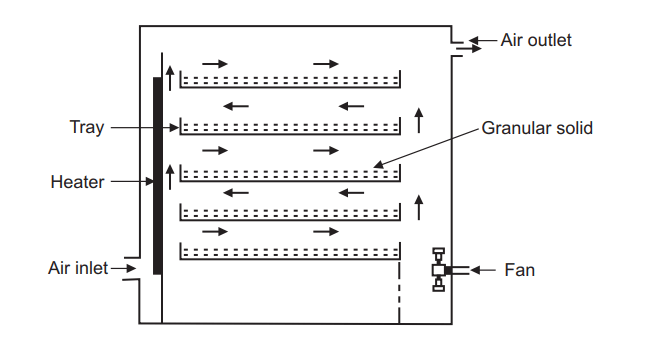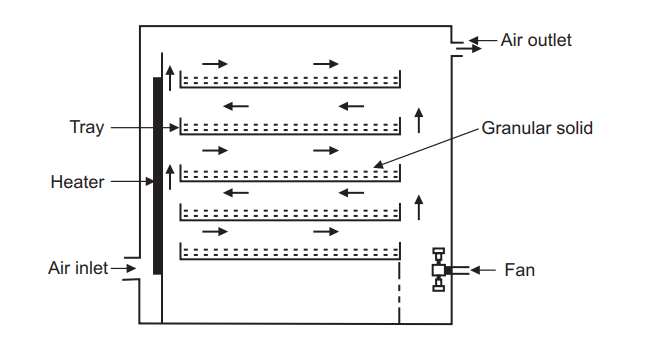Tray drying is a batch process used to dry materials that are liquid or wet cake. Tray drying works well for material that requires more gentle processing or cannot be atomized in an airstream due to viscosity. This dryer is well utilized for drying of wet products like crude drugs, chemicals, powders, or granules, etc. It is the most conventional dryer, used very widely and still being used where the moisture content is higher and where the product has to be dried at a low temperature for long hours.
Table of Contents
Principle of tray Dryer
A laboratory oven is the elementary form of tray dryer which contains a cabinet with a heater at the bottom. The values of these ovens are very less because of their uncontrollable heat transfer or humidity. When we fit a fan in the oven, the circulation of the forced hot air gets started. This process is beneficial for reducing the local flour concentrations and also for increasing the heat transfer. In the direct circulation form the air is heated and then focused on the object in a controlled flow. The material to be dried is dispersed on the tiers of the trays. For the circulation of the air across the drying materials, the screen in trays are perforated and lined with paper. A limited amount of heat is provided to every shelf at that time when the air passes over it to provide the latent heat of vaporization. This kind of dryers provides proper control of humidity and temperature.
Construction of tray Dryer
Tray dryer can be electrically or steam heated. It consists of any number of trays that varies with customer requirement. It is fabricated out of a rigid angle iron frame with double walled panels insulated with the best quality compressed fiberglass and with a rigid door fitted with strong hinges and the best-chosen locking system. There may be a facility to circulate hot air such as fans. A control panel is fixed in the front of the oven to facilitate easy operation. It has a large functional space and is made of mild steel and in good finishing outside with synthetic enamel color and inside painted with heat resistant paint to resist temperature up to 300 ºC.

Working of tray Dryer
Tray dryer is widely used in the pharmaceutical industries. The material to be dried is placed on the trays. The heat in the dryer is produced by the heater along a side or at base. Other than the hot air generated by the oven, the other method is to employ radiator coils that use steam for heat circulation. During the heating process the material to be dried is spread out on the trays. The heated air is directed to flow in a circulation form. It flows over the material in the trays in a controlled flow. Trays can have a solid, perforated or wire mesh base. A paper lining could be used to reduce chances of contamination through contact with the tray. The efficiency of the dryer depends on recirculation of the hot air. Apart from a regular supply and presence of heated air, it also depends on supply of fresh air. The fresh air is combined with the heated air in fixed proportion for an efficient performance. Such regulated drying is important to ensure uniform drying in the dryer at the bottom as well as at the top. Apart from the double-walled construction insulation is achieved by heating coils.
Advantages:
(i) It is operated on batch mode so each batch can be handled as a separate entity.
(ii) It is energy efficient dryer as it consumes less energy.
(iii) It’s simple to use and clean.
(iv) Tray dryer is available in different sizes thus capital cost can be controlled.
(v) Chamber walls are heated externally thus prevents condensation.
(vi) It is available in unique single chamber and multi chamber design with lowest leakage.
(vii) It has excellent surface contact between tray and shelf.
(viii) It is best option in small scale production and drying valuable pharmaceutical materials such as drying wet lumpy solids and wet cakes.
(ix) It has heavy duty hollow shelf design with all connection outside the chamber.
(x) Operating parameter can be controlled more easily.
(xi) Using vacuum systems tray dryers can be best suited for drying of heat-sensitive materials.
Disadvantages
(i) As it is operated at low to intermediate temperatures the process is time-consuming.
(ii) Only a fraction of the solid particles are directly exposed. Heat transfer and mass transfer are comparatively inefficient.
(iii) It provides tendency to over-dry contents in the lower trays.
(iv) The operation is long during cycle (5 to 45 h per batch) and expensive to operate due to high labour requirement for loading and unloading.
(v) Plastic substances can also be dried using this dryer.
(vi) It is not suitable for large scale production.
(vii) Thermolabile drugs, liquids, slurries, cannot be dried.
Applications of tray Dryer
(i) Tray dryer has industrial applications such as in chemical and pharmaceuticals.
(ii) Sticky materials, granular mass or crystalline materials, precipitates, and paste can be dried in a tray dryer.
(iii) It has been used in agricultural drying because of its simple design and capability to dry products at high volume.
